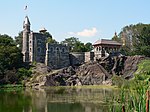King Jagiello Monument
1939 sculpturesBronze sculptures in Central ParkEquestrian statues in New York CityMonuments and memorials in ManhattanOutdoor sculptures in Manhattan ... and 2 more
Polish-American culture in New York CitySculptures in Central Park

The King Jagiełło Monument is an equestrian monument of Władysław II Jagiełło, King of Poland and Grand Duke of Lithuania, located in Central Park, New York City. The monument commemorates the Battle of Grunwald, a decisive defeat of the Teutonic Order in 1410. Originally made for the Polish 1939 New York World's Fair pavilion, the monument was permanently installed in Central Park in 1945. Raised on its grand plinth it is one of the most prominently sited and impressive of twenty-nine sculptures located in the park.
Excerpt from the Wikipedia article King Jagiello Monument (License: CC BY-SA 3.0, Authors, Images).King Jagiello Monument
East Drive, New York Manhattan
Geographical coordinates (GPS) Address External links Nearby Places Show on map
Geographical coordinates (GPS)
| Latitude | Longitude |
|---|---|
| N 40.778888888889 ° | E -73.966666666667 ° |
Address
King Jagiello Monument
East Drive
10021 New York, Manhattan
New York, United States
Open on Google Maps










